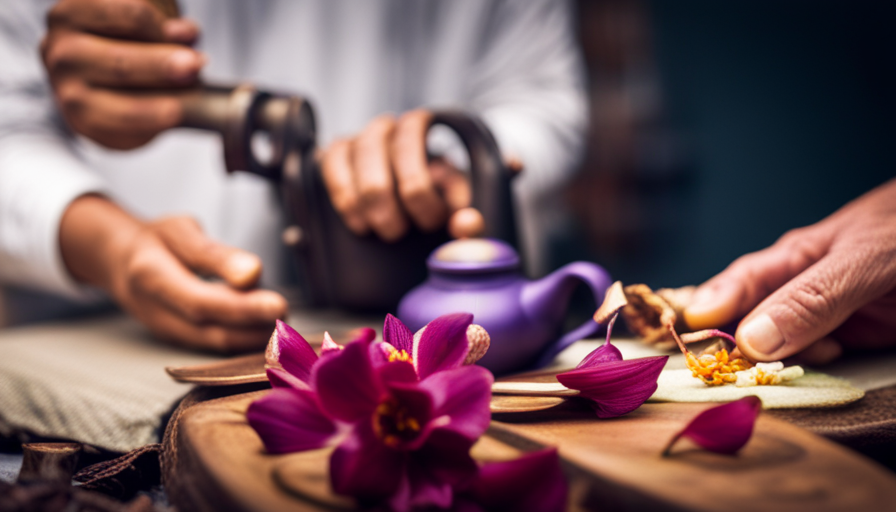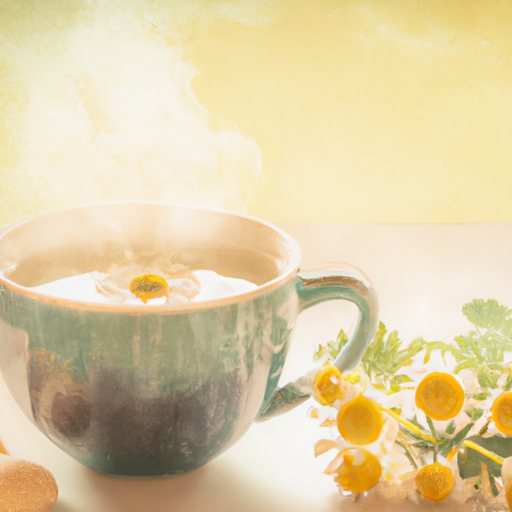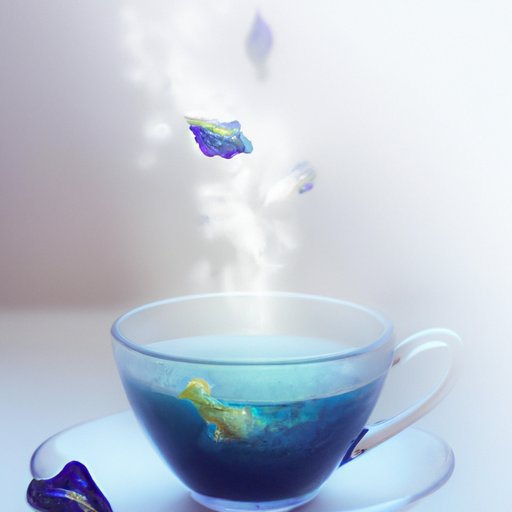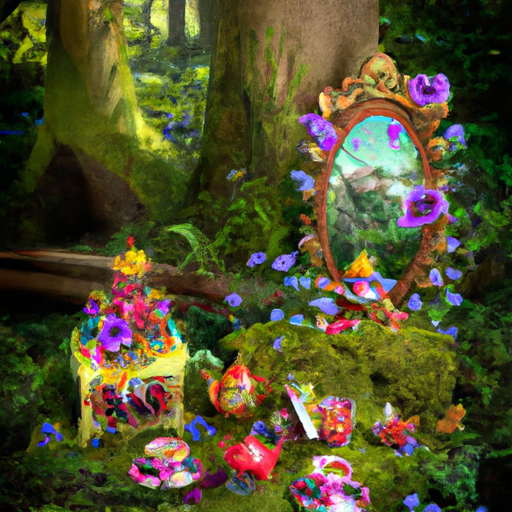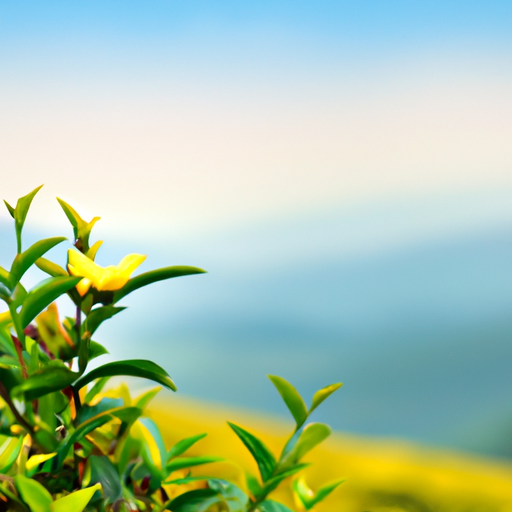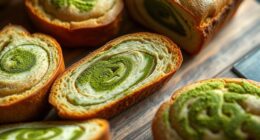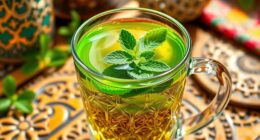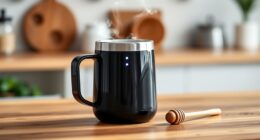Oh, the modest banana flower. Who could have imagined that this simple blossom could offer so much? Today, I am excited to reveal the mysteries of harnessing the magic of banana flower tea. Get ready to be impressed as we explore the blend of tea-making artistry with the health benefits of science.
In this article, I will guide you through the process of selecting the perfect banana flower, cleaning and preparing it, and boiling it to create a fragrant infusion.
We will delve into the world of flavorful ingredients, exploring how they can elevate the taste of our tea. And let’s not forget the health benefits – from promoting heart health to aiding digestion, the banana flower has a lot to offer.
But our journey doesn’t end there. I will also teach you how to store and reheat your tea, ensuring that each cup is as delicious as the first.
So, join me as we dive into the world of banana flower tea and unlock the potential of this hidden gem. Let’s sip our way to blissful wellness!
Key Takeaways
- The right banana flower is important for taste, quality, and health benefits.
- Cleaning involves separating the petals, rinsing them under cold water, and patting them dry.
- Boiling the flower extracts beneficial compounds like antioxidants and flavonoids.
- The tea should be strained carefully to remove residue and impurities.
Selecting the Right Banana Flower
To make the perfect banana flower tea, you’ll want to carefully choose a banana flower that’s still in its early stage of development, ensuring that the petals are tightly packed and the colors are vibrant. Selecting the right banana flower is crucial as it directly impacts the taste and quality of the tea. Not only that, but the right flower will also provide maximum health benefits and enhance the overall experience of this delightful beverage.
When it comes to banana flower recipes, the possibilities are endless. From salads to curries, this versatile ingredient brings a unique flavor and texture to any dish. However, when selecting a flower for tea, it’s important to focus on freshness and visual appeal. Look for flowers that have minimal browning or bruising, as these can affect the taste and appearance of the tea.
In addition to its culinary uses, the banana flower is packed with health benefits. It’s rich in antioxidants, which can help reduce inflammation and boost the immune system. The flower also contains essential vitamins and minerals, such as Vitamin C and potassium. These nutrients contribute to overall well-being and can support heart health.
Now that we’ve selected the perfect banana flower, it’s time to move on to the next step: cleaning and preparing the flower.
Cleaning and Preparing the Flower
First, you’ll want to give the delicate petals a gentle bath, removing any dirt or impurities, so that they can blossom like a pristine canvas ready to be painted with flavors. Cleaning the banana flower is an essential step in preparing this unique tea.
Start by separating each layer of the flower, taking care not to damage the petals. Rinse them under cold water to remove any dirt or insects that may be hiding within. Gently pat them dry with a clean towel.
Once the petals are clean, it’s time to prepare them for the tea. Remove the tough outer layers, as they can be bitter and tough to chew. You can do this by carefully peeling back the layers until you reach the tender, pale yellow petals in the center. These petals are the ones you’ll be using to make the tea.
Banana flower tea has gained popularity due to its numerous health benefits. It’s rich in antioxidants, vitamins, and minerals, making it a great addition to your diet. It has been known to aid digestion, reduce inflammation, and boost the immune system. Incorporating banana flower tea into your routine can be a delicious and nutritious way to promote overall well-being.
Now that the banana flower is clean and prepared, it’s time to move on to the next step: boiling the flower. This will extract the flavors and nutrients, resulting in a fragrant and flavorful tea.
Boiling the Flower
Once the petals are clean and ready, it’s time for me to immerse them in boiling water to unleash their aromatic essence.
Boiling the banana flower is a crucial step in the process of preparing banana flower tea. The boiling technique helps to extract the beneficial compounds present in the flower, such as antioxidants and flavonoids, which contribute to its numerous health benefits.
To begin, I fill a large pot with water and bring it to a rolling boil. Then, I carefully add the cleaned banana flower petals to the boiling water, ensuring they’re completely submerged. I let them boil for about 10-15 minutes, allowing enough time for the water to absorb the flower’s essence and flavor.
This boiling process not only enhances the taste but also helps to release the flower’s therapeutic properties. Once the petals have infused the water with their aromatic goodness, it’s time to move on to the next step of adding flavorful ingredients, transforming this simple tea into a delightful and soothing beverage.
Adding Flavorful Ingredients
Now, it’s time to infuse the boiling water with a burst of delightful flavors by adding in a medley of aromatic ingredients. When it comes to creating flavorful tea recipes, the possibilities are endless.
From herbs to spices, each ingredient adds its own unique taste and aroma to the tea. For a banana flower tea that’s not only delicious but also offers numerous health benefits, consider adding in some ginger, cinnamon, and honey.
Ginger, with its warm and spicy flavor, adds a refreshing kick to the tea. It also has anti-inflammatory properties and can aid in digestion. Cinnamon, on the other hand, adds a sweet and slightly woody taste to the tea. It’s known for its antioxidant properties and can help regulate blood sugar levels. Finally, a drizzle of honey adds a touch of sweetness to balance out the flavors and provides additional health benefits, such as soothing a sore throat and boosting the immune system.
After adding these flavorful ingredients, allow the tea to steep for a few minutes to let the flavors meld together.
The result is a fragrant and invigorating cup of banana flower tea that not only tastes amazing but also provides a multitude of health benefits.
Steeping the Tea
To create a truly aromatic and flavorful cup of tea, the secret lies in the process of allowing the ingredients to steep together, releasing their enticing flavors and scents. Banana flower tea can be steeped using various techniques, each resulting in a unique flavor profile.
One popular method is the hot steeping technique, where the tea leaves and other ingredients are added to hot water and left to infuse for a specific period. This technique allows for a thorough extraction of the tea’s flavors and nutrients, resulting in a robust and well-balanced cup of tea.
Another steeping technique is cold steeping, where the tea leaves and other ingredients are added to cold water and left to infuse in the refrigerator overnight. This method produces a lighter and more delicate flavor profile, perfect for those who prefer a milder taste.
When it comes to the health benefits of steeping banana flower tea, it’s important to note that the longer the steeping time, the more nutrients and antioxidants are released. Studies have shown that prolonged steeping can enhance the tea’s anti-inflammatory properties and promote digestive health.
As we move on to the next section about straining and serving, it’s crucial to strain the tea carefully to avoid any residue or impurities. Straining the tea will ensure a smooth and enjoyable drinking experience, allowing the flavors to shine through.
Straining and Serving
To strain and serve banana flower tea, the first step is to filter out the flower pieces. This can be done by pouring the brewed tea through a fine mesh strainer or cheesecloth, removing any residual flower parts and ensuring a smooth and clear liquid.
Once the tea has been strained, it’s ready to be poured into cups or mugs, allowing the flavors to be enjoyed. Remember to handle the hot tea with caution and serve immediately for the best taste and aroma.
Filtering out the Flower Pieces
Once you’ve steeped the banana flower tea, strain out the flower pieces using a fine mesh sieve. This will ensure that you have a smooth and debris-free tea. Removing flower debris is crucial as it can affect the taste and texture of the tea.
Here are some alternative filtering methods you can try:
-
Cheesecloth: Place a layer of cheesecloth over a bowl or pitcher and pour the steeped tea through it. This will catch any remaining flower pieces.
-
Coffee filter: Line a coffee filter in a funnel and pour the tea through it. The filter will effectively remove the flower debris.
-
Tea infuser: Use a tea infuser with fine holes to strain the tea. This method is especially useful if you have a small amount of tea to strain.
-
Muslin cloth: Wrap the flower pieces in a muslin cloth and squeeze out the tea. The cloth will filter out the debris while allowing the tea to pass through.
Once you have filtered out the flower pieces, you can proceed to pour the tea into cups or mugs, ready to be enjoyed.
Pouring the Tea into Cups or Mugs
Now it’s time to pour that deliciously fragrant tea into your favorite cups or mugs.
There are several different ways to serve banana flower tea, depending on personal preferences and occasion. You can enjoy it hot or chilled, and it can be sweetened with honey or sugar if desired. If you prefer a stronger flavor, you can steep the tea for a longer period of time.
Banana flower tea pairs well with a variety of beverages and snacks. For a refreshing twist, you can serve it over ice with a slice of lemon or lime. It can also be combined with other herbal teas, such as chamomile or mint, for a unique blend of flavors.
As for snacks, banana flower tea complements light and fruity desserts, like a citrus salad or a slice of angel food cake.
Now that the tea is poured, let’s move on to enhancing its flavor by adding some exciting ingredients.
Enhancing the Flavor
First, let your taste buds dance with delight as you infuse your banana flower tea with a touch of honey and a squeeze of lemon. Enhancing the aroma and flavor of your tea can be achieved by experimenting with different sweeteners. The table below provides some options and their corresponding taste profiles:
| Sweetener | Taste Profile |
|---|---|
| Honey | Floral, sweet |
| Stevia | Slightly bitter |
| Agave nectar | Earthy, caramel |
| Maple syrup | Rich, smoky |
To enhance the floral notes of the banana flower tea, try adding a teaspoon of honey. The sweetness of the honey complements the delicate flavor of the tea, creating a harmonious blend. Alternatively, if you prefer a slightly bitter taste, stevia can be a good option. For those who enjoy earthy and caramel flavors, agave nectar can bring a unique twist to your tea. Lastly, if you prefer a rich and smoky taste, consider adding a drizzle of maple syrup.
By experimenting with different sweeteners, you can find the perfect complement to your banana flower tea. The next section will delve into the health benefits of this delightful beverage, allowing you to further explore its potential.
Exploring the Health Benefits
When it comes to exploring the health benefits of banana flower tea, I’m excited to delve into its potential to promote digestive health.
This natural beverage is rich in antioxidants, which can help protect the body against harmful free radicals.
Additionally, packed with essential vitamins, such as vitamin C and vitamin E, banana flower tea can provide a boost to our overall health and well-being.
Promotes Digestive Health
Banana flower tea, with its rich blend of nutrients, aids in promoting optimal digestive health. This herbal infusion is packed with fiber, which helps regulate bowel movements and prevents constipation. Additionally, it contains compounds such as tannins and flavonoids that have anti-inflammatory properties, soothing the digestive tract and reducing the risk of gastrointestinal issues.
To give you some ideas on how to incorporate banana flower into your diet, try adding it to salads, stir-fries, or even as a topping for pizzas. Its unique taste and texture make it a versatile ingredient that can enhance the flavor of your dishes.
In traditional medicine, banana flower has been used for centuries due to its numerous health benefits. Its history and cultural significance are rooted in its ability to aid digestion and treat digestive disorders.
With its digestive benefits covered, let’s now explore how banana flower tea is also rich in antioxidants and vitamins, providing a range of health benefits.
Rich in Antioxidants and Vitamins
Loaded with a plethora of antioxidants and essential vitamins, this herbal infusion is a powerhouse of health benefits. Banana flower tea is packed with antioxidants such as flavonoids and phenolic compounds, which help fight against free radicals and protect the body from oxidative damage. It’s also a rich source of vitamins A, C, and E, which play a crucial role in boosting the immune system and promoting overall well-being. Incorporating banana flower tea into your daily routine can provide numerous benefits, including improved digestion, reduced inflammation, and enhanced heart health. To experience these benefits, simply steep dried banana flower petals in hot water for about 10 minutes.
The resulting tea has a mildly floral flavor with a hint of sweetness. As we move into the next section about storing and reheating, it’s important to note that proper storage and reheating techniques ensure the longevity and flavor of this nutritious tea.
Storing and Reheating
To keep your banana flower tea fresh, store it in an airtight container in the refrigerator. Did you know that properly stored banana flower tea can be reheated and enjoyed for up to three days? Reheating your tea is easy and there are a few methods you can use. One option is to heat it in the microwave for about 30 seconds, stirring halfway through to ensure even heating. Another method is to heat it on the stovetop over low heat, stirring frequently until it reaches your desired temperature. It’s important to note that reheating the tea may cause some loss of flavor and nutrients, so it’s best to consume it fresh if possible.
Now, let’s talk about the shelf life of banana flower tea. When stored correctly, it can last up to three days in the refrigerator. However, the flavor and quality may start to deteriorate after the first day. It’s always best to consume the tea as soon as possible to enjoy its full benefits.
In the next section, we will discuss different ways to enjoy your banana flower tea without compromising its taste and quality.
Enjoying Your Banana Flower Tea
Ready to savor the delightful flavors of your freshly brewed banana flower tea? Here are some tips to enhance your tea-drinking experience:
-
Different ways to sweeten your banana flower tea:
- Honey: Add a drizzle of honey to your tea for a natural and subtle sweetness.
- Stevia: If you prefer a sugar-free option, stevia is a great alternative that adds sweetness without the calories.
- Jaggery: For a unique flavor, try adding a small piece of jaggery to your tea. It imparts a rich, caramel-like taste.
-
Pairing banana flower tea with delicious snacks:
- Fresh fruits: Enjoy your tea with a side of fresh fruits like sliced apples, oranges, or grapes. The fruity flavors complement the floral notes of the tea.
- Nuts and seeds: Crunchy snacks like almonds, walnuts, or pumpkin seeds make a perfect pairing with banana flower tea. They add a satisfying texture and provide a healthy dose of nutrients.
- Baked goods: Indulge in a slice of banana bread or a biscuit while sipping your tea. The warm, comforting flavors of these treats go well with the floral aroma of the tea.
By experimenting with different sweeteners and snack pairings, you can create a truly delightful and unique experience with your banana flower tea. Enjoy!
Frequently Asked Questions
How long should I boil the banana flower for?
To achieve optimal health benefits and extract the medicinal properties of the banana flower, it’s crucial to boil it for an adequate amount of time. The recommended boiling time for the banana flower is approximately 20-30 minutes. This duration ensures that the flower is thoroughly cooked, making it easier to extract its nutrients and beneficial compounds.
Boiling also helps soften the tough texture of the flower, making it more palatable and easier to incorporate into various recipes.
Can I use any type of banana flower for making tea?
Yes, you can use any type of banana flower for making tea. Banana flowers are rich in nutrients and offer numerous health benefits. They’re known for their antioxidant properties and can help improve digestion, reduce inflammation, and regulate blood sugar levels. When used in tea, banana flowers can provide a unique flavor and aroma that pairs well with other herbal teas. So, feel free to experiment with different types of banana flowers to enjoy their benefits in a delicious and soothing cup of tea.
What are some flavorful ingredients that can be added to banana flower tea?
Flavorful additions can enhance the taste of banana flower tea while providing additional health benefits. Some options include ginger, which adds a spicy kick and aids digestion, or lemon, which adds a refreshing citrus flavor and is rich in vitamin C.
Another option is honey, which adds a natural sweetness and has antibacterial properties. These flavorful ingredients not only enhance the taste of banana flower tea but also provide various health benefits.
How long should the tea steep before straining?
When it comes to steeping tea, timing is everything. The best tea steeping technique for banana flower tea is to let it steep for approximately 5-7 minutes before straining. This allows the flavors and nutrients to be extracted fully, resulting in a rich and aromatic brew.
The benefits of banana flower tea are numerous, including its ability to aid digestion, reduce inflammation, and support heart health. So, be patient and let the tea work its magic!
Can I store leftover banana flower tea in the refrigerator?
Yes, you can store leftover banana flower tea in the refrigerator. To ensure its freshness, transfer the tea into an airtight container while it’s still warm. When reheating, use a stovetop or microwave on low heat to avoid overcooking. Remember to strain the tea before storing to remove any solids.
Stored properly, banana flower tea can be refrigerated for up to 2 days. After that, it may start to lose its flavor and quality.
Conclusion
In conclusion, preparing banana flower tea is a simple yet fascinating process that offers numerous health benefits. By selecting the right flower, cleaning it properly, and boiling it with flavorful ingredients, you can create a delicious and refreshing tea.
Interestingly, studies have shown that banana flower tea is rich in antioxidants, which can help fight against free radicals in the body and promote overall well-being.
So why not give this unique tea a try and reap its amazing benefits today?

